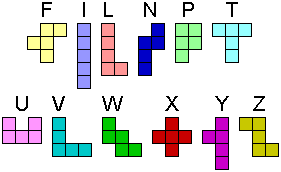Pentominoes

Pentominoes are said to have been invented by Solomon W. Golomb in 1953 at a talk he gave to the Harvard Mathematics Club. Although he coined the name, pentominoes have been around since a much earlier time.
The earliest reference to a puzzle of this sort appears to be in The Canterbury Puzzles, by Henry Dudeney, published in 1907. The idea is so obvious that it may have discovered by many people independently. The pentominoes are able of being assembled into four different rectangles:
- 3 x 20,
- 4 x 15,
- 5 x 12, and
- 6 x 10.
The first investigation of pentominoes by computer was probably by Dana Scott in 1958. The results are summarized in an article by C. J. Bouwkamp in the Journal of Combinatorial Theory published in 1969.
The number of solutions for each are:
- 3 x 20 - 2 solutions
- 4 x 15 - 368 solutions
- 5 x 12 - 1,010 solutions
- 6 x 10 - 2,339 solutions
Source: The Puzzling World of Polyhedral Dissections, Chapter 2 - Two-Dimensional Combinatorial Puzzles, by Stewart T. Coffin
Pentominoes, are shapes made from five squares joined with at least one common side.
- If a shape can be rotated to look like another, the two shapes are considered to be the same.
- If a shape can be flipped to look like another, the two shapes are considered the same.
- Since there are twelve shapes made from five squares, their combined area is sixty squares.
There are twelve shapes, which can be created and they have been named accordingly to their casually related letter shapes: T, U, V, W, X, Y, Z, F, I, L, P, and N.
As a mnemonic device, the names match letters from the end of the alphabet (TUVWXYZ) and the word FLIPN.
With 2,339 solutions, for the 6x10 rectangle, you might expect putting the 12 pieces onto a 6 x 10 array should be easy. If so, you are in for a surprise! If you try...
Puzzles:
- Obvious ones, the four different sized rectangles identified above.
- How many of the pentominoes can be folded into an open box. Also, know as open box patterns, because when folded 8 will make a box and 4 will not.
- Rectangles with areas of: 35, 45, 55, 65, 85, 125,
- A cross with all 60 squares, that is 9 wide, 14 high, and 3 wide at its narrowest